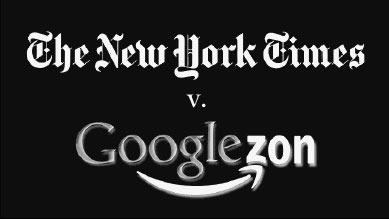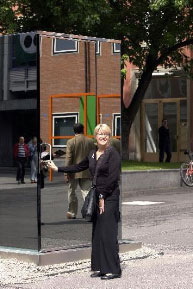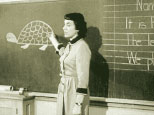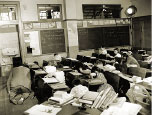 |
→ July 2005 Contents → E-bits
|
E-bits
|
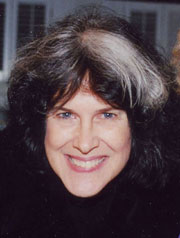 |
||
|
Distinguishing the present from the past or the future is an interesting exercise that often can be a difficult endeavor. The subject of E-bits in June was imagination, as it applies to conceptualizing the future. Alternatively, most of us have witnessed the phenomena of imaginatively rewriting history or reinventing oneself, a business, or profession. Imagination is at play in the reinterpretation of long-held standards, such as we are currently seeing in regard to the U.S. Constitution and the Fourth Estate. These forms of refashioning reality are emerging aggressively all the time in our world today, and they carry names with dubious repute: spin, propaganda, manipulation. But what of the positive connotations, such as adaptation, flexibility, and openness to change?
Imagining or fantasizing how the future might unfold is something we can do privately with no commitment or boundaries, no obligation to veracity, and free from the intrusion of outside reality that might prevent a vision from being realized. This is the driving force of creativity, the stuff of the artists, the joy of musicians, and the task of architects, both in the sense of designers and/or masterminds or projects, of business, or war. Visionaries flock to think tanks or conventions to be around others who are similarly creative, or perhaps they seek solitude to call upon muses or other sources of inspiration. Each artist marches to the beat of a different drummer, but it is in those differences, it is said, that there is commonality. What happens when many share a common vision, fantasy, or even delusion? What about the present, or, the future? And what, then, about reality? The following video, EPIC 2014, is a visionary animation created by Robin Sloan and Matt Thompson, with music by Minus Kelvin. EPIC 2014 gives a rather chilling look at the possibilities of future consolidation of existing interactive technology, corporate concerns, and society. Click on the image below and follow the link to watch the amazing and thought-provoking EPIC 2014.
What about the idea of transparency? I went to the NPPA Conference and Best of Photojournalism Awards recently, and heard the buzzword "transparency" at least 10 times. Of course, the transparency that journalists discuss refers to the full, accurate, and timely disclosure of information. But for the purposes of E-Bits, transparency makes me think about these photos that arrived anonymously over e-mail about a year ago. They are taken by an unknown photographer on a street in an unknown town in Switzerland. The first photo shows the outside, the second, the inside of a personal relief station. One-way transparency: a toilet. Tell me, would you use this facility?
Once the conventional boundaries of reality — and transparency — are broken, anything is possible. A while ago, an unidentified aide close to an unnamed awesome source of power told author and journalist Ron Suskind the world works differently now, that even someone whom former Treasury Secretary Paul O'Neill has likened to "a blind man in a room full of deaf people" is busy creating new reality upon new reality that the old, reality-based Fourth Estate can study—judiciously, so he said, as it will. But if that is so, then, to echo the not-forgotten lyrics of Chicago Transit Authority, does anybody really know what time it is? According to this clock displayed on Route 39 in Pennsylvania, apparently not. Though we don't know to what she was referring, columnist Nancy Eshelman of The Patriot News said "it's hardly the only thing mixed up around here."

What is required to let go of a tenacious grip on an outmoded reality, anyway? For some, it may be bravery. For others, perhaps naiveté, or maybe an intensely creative spirit, always forging ahead nomadically into new territories. It is certainly human nature, as evidenced by all of history, to create change. Unfortunately, one of the greatest aids to change is the use of fear. It only takes a look around at our rapidly changing world to see that the most prominent emotional response these days in the hearts and minds of the majority of people is fear. This is not new.
Those of us who were alive in the '50s will remember the frightening reality of a new atomic age with an unknown future, and our grandparents told us firsthand stories about the fear of nerve gas in WWI. Fear has always been around. What a noble endeavor it would be to create a world absent of manufactured, fear-inducing notions. Meanwhile, as a review or for the first time, enjoy and learn from a 1951 U.S. Civil Defense film made with the cooperation of public schools in Astoria, N.Y., on Nuclear Safety Training. The first showing of DUCK AND COVER was in Washington, D.C., in January of 1952. Following that, 10 large trucks and trailers toured the country for the next nine months as "The Alert America Convoy," showing the film in schools and towns. According to an information Web site, this film was known as the "Citizen Kane of Civil Defense," and The Convoy promoted it "like a Hollywood B-movie with screaming posters that read: 'Don't miss it—it's the show that could save your life.' " You might have been wondering lately what to do in case of a nuclear attack. Bert the Turtle gives this answer here, in the now-classic DUCK AND COVER.
Judging from visionaries of the past, only a small percentage of what is imagined is realized. On the other hand, things we could never imagine have a way of happening completely unforeseen. The consensus lately seems to be, "hang in there," as the rapid contraction, expansion, and shifting elements of reality are forcing us into a constant state of change. Adaptability is key, and keeping one's eyes fixed on an ever-changing present is necessary as the past and future morph into figments of somebody else's imagination. The Buddhist notion of freeing ourselves to live in the eternal Now is illustrated by the story that you can't step in the same river twice. A river is constantly flowing, and since no river stands still, nothing can be captured, isolated, or repeated. That can happen only in the mind, in memory. With photography, we capture a split-second slice of reality, but the moment we captured is in fact gone forever. Photography surely must be the greatest tool ever invented to bring us to awareness and consciousness. But, what must we do with that awareness beyond self-consciously living and reliving the moment, and however judiciously, studying it? Whatever we must do, I'm not quite sure, but this month, I'm going to try to find out.
Have a great July.
© Beverly Spicer
The links that appear in this column are from the World Wide Web. Credit is given where the creator is known. The Digital Journalist and the author claim no copyright ownership of any video or photographic materials that appear herein. |
|||
Back to July 2005 Contents
|
|
